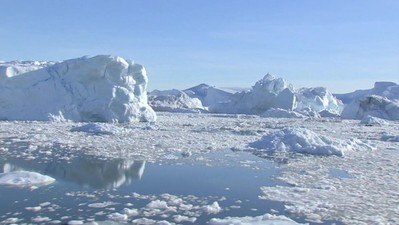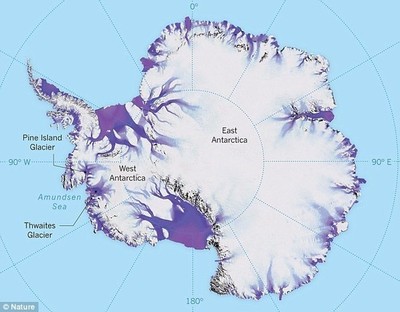 ▲ The Melting Thwaites Glacier in Antartica
▲ The Melting Thwaites Glacier in AntarticaRecent studies show that the outer edges of giant glaciers in Antarctica are rapidly breaking down.
First of all, the Thwaites Glacier of Antarctica, called as the Doomsday Glacier, is a glacier adjacent to the Amundsen Sea nearby west Antarctica, of which area is similar to the entire Korean Peninsula. There is a big hole like a tunnel beneath the glacier, but the matter is that the hole is getting bigger every year due to climate change by global warming. Kelly Hogan of the British Antarctic Survey said that the survey team discovered very large holes thousands of kilometers underneath the Thwaites Glacier and analyzed how much more heat of the seawater can reach the glacier, which was estimated that it would reach twice more into large holes than small ones. The British and U.S. joint research team estimated that the inflow of seawater into the hole would double, based on data such as icebreakers and aerial photographs. Scientists are concerned about the melting of the Thwaites Glacier that would raise the sea level around the world by about 65 centimeters. In particular, they warned that the collapse of it supporting the west Antarctic ice sheet could result in a chain-collapse of surrounding ice shelves, additionally raising sea level by more than two meters.
 ▲ Each Location of Thwaites Glacier and Pine Islan Glacier in Antarctica
▲ Each Location of Thwaites Glacier and Pine Islan Glacier in Antarctica
Second, according to the Washington Post, international researchers published in the American National Academy of Journal a satellite analysis result that the friction of the ice shelves located in the edges of both the Pine Island Glacier and the Thwaites Glacier in the Amundsen Sea is weakening. Researchers found out that the ice shelves on Pine Island has been broken and gone since 1999, and the speed of its being broken has increased since 2016. It was showed that the area of the ice shelves of western or central Pine Island has been reduced by 30 percent for recent six years, as the size of Los Angeles in the United States.
These melting Pine Island Glacier and Thwaites Glacier are believed to have contributed about five percent to the rise of sea level across the globe. This is seen as a sign that the outflow of Antarctic ice would accelerate, leading to a concern for the global sea-level rise.
September 25th, 2020
by Kim Hyeon
다른 곳에 퍼가실 때는 아래 고유 링크 주소를 출처로 사용해주세요.


신정고등학교 3학년